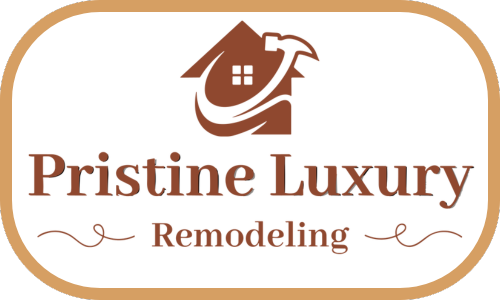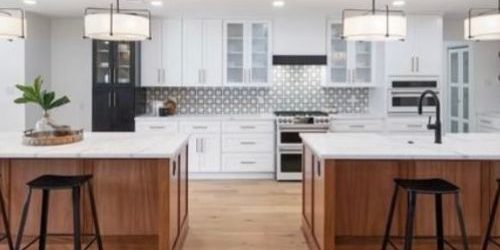Home remodeling is an exciting opportunity to update your living space, improve functionality, and increase property value. With the rapid advancement of smart home technology, integrating these innovative solutions into your remodel can transform your home into a more convenient, efficient, and secure environment. In this blog post, we’ll explore practical ways to incorporate smart home technology and enhance your living experience.
By carefully planning and selecting the right devices, you can create a home that is more secure, efficient, and enjoyable. Let’s dive into the details!
Home Office and Productivity
Smart Home Office Setup
Designing a comfortable and efficient home office involves incorporating ergonomic furniture and smart technology to enhance productivity and well-being. Start with an adjustable standing desk and an ergonomic chair to support good posture, and add a monitor stand, keyboard tray, and ergonomic mouse to reduce strain. Utilize smart plugs to control office equipment remotely, such as turning off the printer after hours, and install smart lighting to adjust brightness and color temperature for optimal working conditions. A multi-functional desk with built-in storage helps keep the workspace organized, while noise-canceling headphones or a white noise machine can minimize distractions. By thoughtfully integrating these elements, you create a home office that promotes comfort, efficiency, and focus.
Automated Task Management
Integrating task management apps with voice assistants can significantly boost productivity in your home office by providing hands-free task updates and efficient time management. By linking apps like Todoist, Trello, or Microsoft To-Do with voice assistants such as Amazon Alexa, Google Assistant, or Apple Siri, you can use voice commands to add or update tasks, set reminders, and receive notifications for important deadlines. This integration allows you to effortlessly manage your tasks without interrupting your workflow, enabling you to stay organized and focused. For instance, you can simply say, “Hey Google, remind me to submit the report by 3 PM,” or “Alexa, add a task to call the client tomorrow at 10 AM.”
Energy-Efficient Workspaces
Installing smart blinds or curtains can greatly enhance the comfort and efficiency of your home office by regulating natural light and temperature. These smart window treatments can be programmed to open and close at specific times or controlled remotely, allowing you to maximize natural light during the day and reduce glare on your computer screen. Additionally, they can help maintain a comfortable temperature by blocking excessive heat in the summer and retaining warmth in the winter, thereby improving energy efficiency. Alongside smart blinds, opting for energy-efficient LED bulbs in your home office is a smart choice. LED bulbs consume less energy, last longer, and provide better lighting quality compared to traditional bulbs. They can also be adjusted for brightness and color temperature, which is ideal for reducing eye strain and creating an optimal work environment. Together, these smart solutions contribute to a more comfortable, efficient, and eco-friendly home office setup.
Wellness and Health
Smart Fitness and Wellness Devices
Exploring smart fitness trackers, scales, and wearables can help you monitor health metrics and maintain a healthy lifestyle while working from home. Devices like Fitbit, Apple Watch, and Garmin track your physical activity, heart rate, sleep patterns, and more, providing valuable insights into your overall health. Pair these with smart scales that measure weight, body fat percentage, and other vital metrics for a comprehensive view of your fitness progress. To ensure regular exercise breaks, set up reminders using smart speakers like Amazon Echo or Google Home. You can program these devices to alert you at specific intervals to take a break, stretch, or engage in a quick workout, promoting better physical health and reducing the risks associated with prolonged sitting. Integrating these technologies into your home office routine supports a balanced approach to work and wellness.
Sleep Optimization
Using smart mattresses that adjust firmness and track sleep patterns can significantly improve your sleep quality and overall health. These mattresses, such as those offered by Sleep Number or Eight Sleep, can automatically adjust to provide optimal support and comfort, while also monitoring your sleep cycles, heart rate, and breathing patterns. This data helps you understand your sleep habits and make adjustments to improve your rest. Additionally, installing smart lighting with warm tones in your bedroom can promote relaxation before bedtime. Smart bulbs from brands like Philips Hue or LIFX can be programmed to gradually dim and shift to warmer colors in the evening, mimicking natural sunset light, which helps signal to your body that it’s time to wind down. Together, these smart technologies create a conducive environment for better sleep, enhancing your overall well-being.
Air Quality Monitoring
Investing in smart air purifiers and monitors is a great way to maintain healthy indoor air quality in your home. Smart air purifiers, such as those from Dyson or Blueair, can automatically adjust their settings to filter out pollutants, allergens, and dust, ensuring a cleaner and healthier environment. Paired with smart air quality monitors like those from Airthings or Awair, you can keep track of various air quality metrics such as levels of PM2.5, VOCs, CO2, and humidity in real-time. These devices can send alerts to your smartphone when air quality levels become suboptimal, allowing you to take immediate action to improve your indoor air. By using smart air purifiers and monitors, you can ensure that the air in your home remains clean and safe, contributing to better respiratory health and overall well-being.
Future-Proofing Your Home
Scalable Systems
Choosing smart devices that can be easily upgraded or expanded as technology evolves is crucial for future-proofing your home. Opt for devices that support firmware updates and can integrate with new features as they become available. Additionally, consider compatibility with emerging standards like Zigbee, Z-Wave, or Thread. These standards enable interoperability between different smart devices and ecosystems, ensuring that your home automation system remains versatile and scalable. For instance, smart hubs that support multiple protocols can connect various devices, allowing you to expand your smart home setup without compatibility issues. By selecting upgradeable and compatible devices, you ensure that your home remains up-to-date with the latest advancements in smart technology, providing long-term value and flexibility.
Privacy and Security
Regularly updating firmware and changing default passwords are essential practices to protect your smart devices from cyber threats. Keeping firmware up-to-date ensures that you benefit from the latest security patches and improvements, reducing vulnerabilities that could be exploited by hackers. Changing default passwords to strong, unique ones helps prevent unauthorized access to your devices and personal data. Additionally, educating family members about privacy settings and data sharing is crucial for maintaining overall security. Ensure everyone understands how to manage privacy settings, limit data sharing, and recognize potential phishing attempts or other security risks. By staying vigilant and informed, you can safeguard your smart home environment and protect your personal information from cyber threats.
Sustainability and Energy Savings
Exploring solar panels, smart thermostats, and energy-efficient appliances can significantly enhance your home’s energy efficiency and sustainability. Solar panels harness renewable energy from the sun, reducing reliance on traditional power sources and lowering utility bills. Smart thermostats like those from Nest or Ecobee can be programmed to adjust temperatures based on your schedule, learning your preferences over time to optimize heating and cooling while minimizing energy use. Energy-efficient appliances, such as those with ENERGY STAR ratings, consume less power and reduce overall energy consumption compared to standard models. To maximize these benefits, regularly monitor your energy usage using smart home energy monitors or apps that track consumption patterns.
Smart Lighting and Climate Control
Smart Lighting
Installing smart bulbs or switches that can be controlled via smartphone or voice commands offers convenience and energy savings. Smart bulbs allow you to adjust lighting settings, such as brightness and color, remotely or through voice commands with devices like Amazon Alexa or Google Assistant. Smart switches enable you to control traditional lights and appliances from your smartphone, providing flexibility and efficiency. Additionally, incorporating motion sensors in hallways, bathrooms, or outdoor spaces can further enhance automation. These sensors automatically turn lights on when movement is detected and off after a period of inactivity, reducing energy waste and improving safety.
Climate Control
Installing a smart thermostat that learns your schedule and preferences can optimize energy use and enhance comfort. These thermostats, such as those from Nest or Ecobee, automatically adjust the temperature based on your daily routines, reducing energy consumption when you’re away and ensuring comfort when you’re home. For even greater efficiency, consider a zoned heating and cooling system, which allows you to set different temperatures for various areas of your house. This approach ensures that each zone is heated or cooled according to its specific needs, potentially reducing overall energy use and improving comfort. By combining a smart thermostat with zoned systems, you can achieve a more customized and efficient climate control solution tailored to your home’s unique layout and your personal preferences.
Smart Locks
Using smart locks that can be controlled remotely, provide access codes, and integrate with other systems enhances home security and convenience. These locks allow you to manage access to your home from anywhere, set temporary or permanent access codes for guests or service providers, and receive notifications about lock status. Complement these with smart security cameras and doorbells that offer video streaming and recording. These devices provide real-time video feeds, allowing you to monitor your property from your smartphone and review recorded footage if needed. Additionally, integrating a smart alarm system with features like motion detection and remote alerts further boosts security.
Answering Common Questions
Q1 How secure are smart home devices?
A1 Smart home devices vary in security features. To enhance security, regularly update firmware to patch vulnerabilities. Change default passwords: Use strong Wi-Fi encryption (WPA3).
Q2 Can I integrate different smart home ecosystems?
A2 Yes! Some hubs (e.g., SmartThings, Home Assistant) support multiple protocols (Zigbee, Z-Wave, Wi-Fi). Choose devices that work well together.
Q3 What about privacy concerns?
A3 Be mindful of data collection. Read privacy policies, limit data sharing, and disable features you don’t need.
The Impact of Smart Home Technology
Smart home technology impacts our lives in several ways. It enhances convenience by allowing remote control of devices, automating routines, and saving time. Energy efficiency is improved with smart thermostats, lighting, and appliances that reduce energy consumption.
Seeking Expert Advice
While DIY installation is possible, consider professional help for complex setups, such as electrical work involving wiring for smart switches, outlets, and fixtures. Professional assistance is also recommended for installing security systems, including cameras, sensors, and alarms. Additionally, ensuring robust Wi-Fi coverage for all devices may require expert guidance in network setup.
Conclusion
Incorporating smart home technology into your remodel isn’t just about convenience—it’s about creating a home that adapts to your lifestyle, enhances security, and promotes energy efficiency. With options ranging from smart lighting that adjusts to your needs, to advanced security systems that offer real-time monitoring and alerts, the possibilities are endless. By integrating technologies like smart thermostats, security cameras, and energy-efficient appliances, you can design a living space that responds to your preferences and enhances your daily life. Embrace these innovations to transform your home into a futuristic haven that seamlessly blends comfort, security, and sustainability.
Visit us at Pristine Luxury Remodeling
For more information and personalized guidance visit us at Pristine Luxury Remodeling, We specialize in providing exceptional remodeling services that elevate your space into a masterpiece of luxury.







